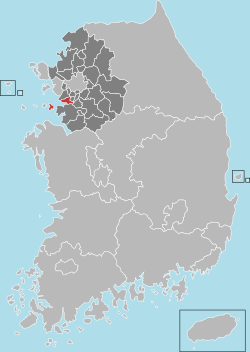This article needs additional citations for verification. (June 2009) |
Ansan
안산시 | |
|---|---|
| Korean transcription(s) | |
| • Hangul | 안산시 |
| • Hanja | 安山市 |
| • Revised Romanization | Ansan-si |
| • McCune–Reischauer | Ansan-si |
 Location in South Korea | |
| Coordinates: 37°19′0″N 126°50′0″E / 37.31667°N 126.83333°E | |
| Country | |
| Region | Gyeonggi Province (Sudogwon) |
| First mention | 940 |
| City status | 1986 |
| Administrative divisions | 2 gu, 25 dong |
| Government | |
| • Mayor | Lee Min-Geun (People Power Party) |
| Area | |
| • Total | 149.39 km2 (57.68 sq mi) |
| Elevation | 9 m (30 ft) |
| Population (September 2024[1]) | |
| • Total | 623,256 |
| • Density | 4,200/km2 (11,000/sq mi) |
| • Dialect | Seoul |
| Postal code | 425020-426910 |
| Area code | (+82) 31 |
| Bird | Chinese egret[2] |
| Flower | Rose |
| Tree | Ginkgo |
| Website | ansan.go.kr |
Ansan (Korean: 안산, Korean pronunciation: [an.san]) is a city in Gyeonggi Province, South Korea. It lies southwest of Seoul and is part of the Seoul National Capital Area. It is connected to Seoul by rail via Seoul Subway Line 4. It is situated on the Yellow Sea coast and some islands lie within its jurisdiction. The largest and best-known of these is Daebu Island.
Several higher learning institutions are located in Ansan. They include Ansan University, Shin Ansan University, Seoul Institute of the Arts, the ERICA campus of Hanyang University, and the Seoul Institute of the Arts. The Korea Transportation Safety Authority, a government agency, has also been headquartered in Ansan since June 3, 2002.[3][4] With its high number of foreign workers, Wongokbon-dong has been designated as a multicultural area.[5] In 2021, Ansan was selected as the largest residential area for foreigners and it is seeking designation as a special multicultural city.[6] Street play festival is held every year in Ansan.
- ^ "Population statistics". Korea Ministry of the Interior and Safety. 2024.
- ^ "Symbol". Ansan-si. Archived from the original on 2019-01-25. Retrieved 2016-10-04.
- ^ Home page. Korea Transportation Safety Authority. Retrieved on June 9, 2009.
- ^ Seungwoon, Song jungsun, Kim hyejin, Joe. 교통안전공단 - 공단소개 > 공단소개 > 일반현황 > 설립목적 및 연혁 > 2000년 이후. Archived from the original on 2017-09-29. Retrieved 2016-04-25.
{{cite web}}: CS1 maint: multiple names: authors list (link) - ^ [창간특집]그 곳에 가면 외국의 축제가 있다 (in Korean). 2009-06-02. Retrieved 2018-04-11.
- ^ '외국인 최다 거주' 안산시, 다문화 특례시 지정 추진. 연합뉴스TV (in Korean). 2021-04-06. Retrieved 2021-04-08.

